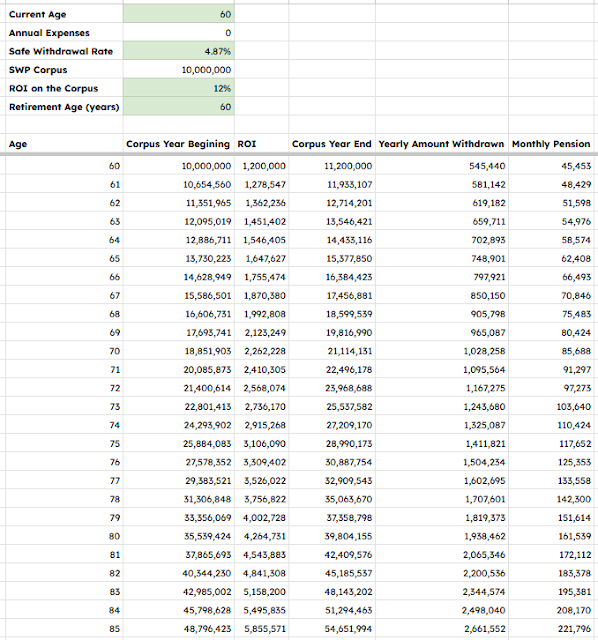Are You Worried About Running Out of Money in Retirement?
Let’s talk about a smart, proven method to retire rich — and stay rich.
What Will You Learn in This Blog?
-
What is the 4.8% SWP Rule?
-
How this rule works better than traditional retirement tools
-
How it helps you beat inflation effortlessly
-
Why mutual funds make this rule possible
-
Simple, bullet-style explanation for easy understanding
-
Real-life benefits: Peace of mind, monthly income & capital growth
-
Final recap with verdict to help you decide confidently
What is the 4.8% SWP Rule?
-
SWP = Systematic Withdrawal Plan.
-
The 4.8% Rule means withdrawing only 4.8% of your mutual fund corpus every year.
-
This keeps your capital mostly intact — and may even grow.
-
You get a monthly income without depleting your wealth.
-
It’s smarter than the old 4% rule in today's Indian market conditions.
Why 4.8% and Not 4%?
-
India’s mutual fund returns are higher than developed countries.
-
Historical equity mutual fund returns in India: ~12-14% p.a.
-
Inflation averages around 6-7%.
-
4.8% is a sweet spot: Enough for regular income + capital appreciation.
-
Research-backed and inflation-proofed for Indian retirees.
How Does SWP Actually Work?
-
You invest a lump sum in mutual funds (preferably hybrid or equity-oriented).
-
You opt for SWP at 4.8% of the invested amount per year.
-
Mutual fund house pays you a monthly payout from your own investment.
-
The rest of your corpus continues to grow in the market.
Inflation? What Inflation?
-
Your invested money isn’t sitting idle like in FDs.
-
It’s growing, compounding, and beating inflation quietly.
-
Mutual funds help your capital grow, unlike traditional savings methods.
-
You enjoy both income and wealth creation!
Why Not Just Use Fixed Deposits Instead?
-
FDs give 6-7%, but are tax-inefficient.
-
FD interest is taxed fully every year.
-
No growth potential — only interest.
-
SWP in mutual funds? Tax-efficient, flexible, and profitable.
-
You only pay tax on the withdrawn gains
Best Mutual Funds for SWP
-
Hybrid Equity Funds (Balanced Advantage, Aggressive Hybrid)
-
Equity Savings Funds
-
Choose funds with consistent performance over 5+ years or consult a Mutual Fund Advisor
Do you know you can plan your monthly income just like a salary during retirement?
Real-Life Example: How Much Monthly Income Can You Really Get?
Let’s break it down with a real and practical example using the 4.8% SWP Rule on a ₹1 crore retirement corpus.Can your investments give you a growing monthly income for life?
Starting Retirement at Age 60:
- Corpus Invested: ₹1,00,00,000 (₹1 Crore)
- Annual Withdrawal Rate: 4.8%
- Return on Investment (ROI): 12% annually
- SWP Mode: Monthly pension starting at ₹45,453
How Does It Grow Over Time?
Even while withdrawing money every year, your corpus keeps growing due to a higher return than withdrawal rate.
Here’s how:
Age 60:
-
ROI Earned: ₹12,00,000
-
Corpus Grows to: ₹1.12 Crore
-
Annual Withdrawal: ₹5,45,440
-
Monthly Pension: ₹45,453
Age 65:
-
Corpus Becomes: ₹1.54 Crore+
-
Monthly Income Rises To: ₹62,408
Age 70:
-
Corpus Crosses: ₹2.1 Crore+
-
Monthly Income Becomes: ₹85,688
Age 75:
-
Corpus Nears: ₹2.98 Crore
-
Monthly Pension: ₹1,17,628
Age 80:
-
Corpus Touches: ₹3.98 Crore+
-
Monthly Income: ₹1,62,054
Age 85:
-
Corpus Hits: ₹5.46 Crore!
-
Monthly Withdrawal: ₹2,21,796
What Does This Mean for You?
-
Your monthly income more than quadruples from ₹45K to ₹2.2L over 25 years!
-
Your corpus grows over 5 times, despite regular withdrawals.
-
You’re not just living on your savings — your money is working for you.
 |
| Detailed Illustration |
Would you believe that ₹1 Crore can generate ₹2.2 Lakhs/month in 25 years? Comment Below
SWP Rule = Financial Freedom + Mental Peace
-
No fear of outliving your savings
-
Regular income like a pension
-
Growth even after retirement
-
Flexibility to increase/decrease withdrawal
-
Control stays with you, not the bank
How to Start the 4.8% SWP Plan
-
Step 1: Choose suitable mutual fund(s)
-
Step 2: Invest your retirement corpus
-
Step 3: Set up SWP online or via your mutual fund advisor
-
Step 4: Choose monthly payout frequency
-
Step 5: Review performance every 6–12 months either through DIY or mutual fund advisor
When Should You NOT Use SWP?
-
If your corpus is too small — then it’ll get exhausted fast
-
If you need large lump sums often
-
If your withdrawal rate exceeds 6% p.a.
-
If you’re investing in any volatile or small-cap funds
Extra Tips to Maximise the 4.8% Rule
-
Mix equity and debt funds for balance
-
Start SWP after 1-year holding to reduce tax
-
Reinvest any surplus to grow more
Consult a good Mutual Fund Advisor
Recap: Why the 4.8% SWP Rule is a Game-Changer
-
Offers regular, tax-friendly income
-
Beats inflation while maintaining capital
-
Uses the power of mutual fund growth
-
Customisable & flexible
-
A practical retirement tool for modern Indian investors
✅ Final Verdict
The 4.8% SWP Rule is your golden key to peaceful retirement living.
It gives you monthly income, capital protection, inflation-beating returns, and total control over your wealth.
Forget old-school pensions or FDs. With this simple rule, you become your own boss — even after retirement.


This comment has been removed by the author.
ReplyDeleteThank you for sharing such a wonderful blog. It has truly changed the way I think.
DeleteThanks a lot Rajesh for the encouragement!. :)
DeleteWill keep writing more such ideas